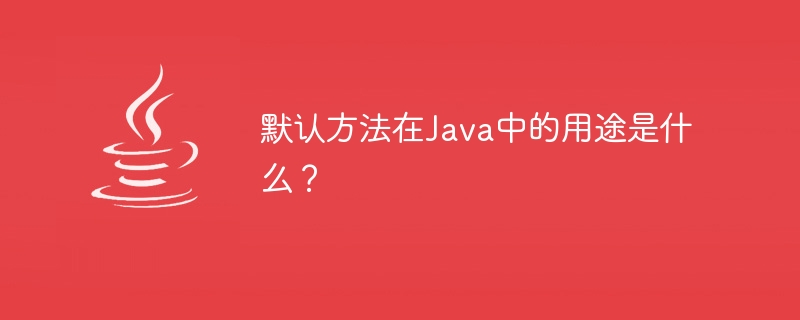What is the use of default methods in Java?

An interface in Java is similar to a class, but it only contains abstract methods and fields modified by final and static.
- It is the specification of method prototype. Whenever you need to instruct programmers or make a contract about how a type's methods and fields should be, you define an interface.
- If you want your class to follow a certain specification, you need to implement the required interface and provide concrete implementations for all abstract methods in the interface.
- If you do not provide implementations of all abstract methods in the interface, a compile-time error will be generated.
What happens if a new method is added to the interface?
Suppose we are using an interface and have implemented all the abstract methods in the interface, and then added new methods later. Then all classes using that interface will not work unless you implement the newly added method in every class.
To solve this problem, Java8 introduced default methods.
Default method
Default method is also known as defense method or virtual extension method. You can define a default method using the default keyword as follows:
default void display() {
System.out.println("This is a default method");
}Once a default implementation is written for a specific method in an interface, it is There is no need to implement it in the class.
The following Java example demonstrates the use of default methods in Java.
Example
Online Demonstration
interface sampleInterface{
public void demo();
default void display() {
System.out.println("This is a default method");
}
}
public class DefaultMethodExample implements sampleInterface{
public void demo() {
System.out.println("This is the implementation of the demo method");
}
public static void main(String args[]) {
DefaultMethodExample obj = new DefaultMethodExample();
obj.demo();
obj.display();
}
}Output
This is the implementation of the demo method This is a default method
The above is the detailed content of What is the use of default methods in Java?. For more information, please follow other related articles on the PHP Chinese website!

Hot AI Tools

Undresser.AI Undress
AI-powered app for creating realistic nude photos

AI Clothes Remover
Online AI tool for removing clothes from photos.

Undress AI Tool
Undress images for free

Clothoff.io
AI clothes remover

AI Hentai Generator
Generate AI Hentai for free.

Hot Article

Hot Tools

Notepad++7.3.1
Easy-to-use and free code editor

SublimeText3 Chinese version
Chinese version, very easy to use

Zend Studio 13.0.1
Powerful PHP integrated development environment

Dreamweaver CS6
Visual web development tools

SublimeText3 Mac version
God-level code editing software (SublimeText3)

Hot Topics
 Square Root in Java
Aug 30, 2024 pm 04:26 PM
Square Root in Java
Aug 30, 2024 pm 04:26 PM
Guide to Square Root in Java. Here we discuss how Square Root works in Java with example and its code implementation respectively.
 Perfect Number in Java
Aug 30, 2024 pm 04:28 PM
Perfect Number in Java
Aug 30, 2024 pm 04:28 PM
Guide to Perfect Number in Java. Here we discuss the Definition, How to check Perfect number in Java?, examples with code implementation.
 Random Number Generator in Java
Aug 30, 2024 pm 04:27 PM
Random Number Generator in Java
Aug 30, 2024 pm 04:27 PM
Guide to Random Number Generator in Java. Here we discuss Functions in Java with examples and two different Generators with ther examples.
 Armstrong Number in Java
Aug 30, 2024 pm 04:26 PM
Armstrong Number in Java
Aug 30, 2024 pm 04:26 PM
Guide to the Armstrong Number in Java. Here we discuss an introduction to Armstrong's number in java along with some of the code.
 Weka in Java
Aug 30, 2024 pm 04:28 PM
Weka in Java
Aug 30, 2024 pm 04:28 PM
Guide to Weka in Java. Here we discuss the Introduction, how to use weka java, the type of platform, and advantages with examples.
 Smith Number in Java
Aug 30, 2024 pm 04:28 PM
Smith Number in Java
Aug 30, 2024 pm 04:28 PM
Guide to Smith Number in Java. Here we discuss the Definition, How to check smith number in Java? example with code implementation.
 Java Spring Interview Questions
Aug 30, 2024 pm 04:29 PM
Java Spring Interview Questions
Aug 30, 2024 pm 04:29 PM
In this article, we have kept the most asked Java Spring Interview Questions with their detailed answers. So that you can crack the interview.
 Break or return from Java 8 stream forEach?
Feb 07, 2025 pm 12:09 PM
Break or return from Java 8 stream forEach?
Feb 07, 2025 pm 12:09 PM
Java 8 introduces the Stream API, providing a powerful and expressive way to process data collections. However, a common question when using Stream is: How to break or return from a forEach operation? Traditional loops allow for early interruption or return, but Stream's forEach method does not directly support this method. This article will explain the reasons and explore alternative methods for implementing premature termination in Stream processing systems. Further reading: Java Stream API improvements Understand Stream forEach The forEach method is a terminal operation that performs one operation on each element in the Stream. Its design intention is






